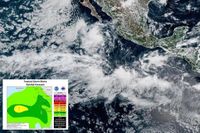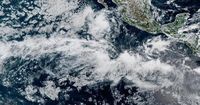Tropical Storm Mario, a weather system that has kept meteorologists on their toes, has once again made headlines after reforming off Mexico’s Pacific coast. The storm’s unpredictable behavior has sparked interest not only among weather experts but also among residents along the West Coast and in the Bay Area, as it threatens to bring unusual weather patterns and potential wildfire risks to California later in the week.
According to the National Hurricane Center in Miami, Mario first gained tropical storm strength on Friday, September 12, 2025, before quickly weakening into a tropical depression just hours later. But the story didn’t end there. By Sunday morning, September 14, Mario had regained tropical storm status, swirling about 20 miles (35 kilometers) east-northeast of Socorro Island and roughly 280 miles (450 kilometers) south of the southern tip of Mexico’s Baja California peninsula. At that point, maximum sustained winds were clocked at 45 mph (75 kph), and the storm was moving west-northwest at a gentle 7 mph (11 kph).
Despite the storm’s strengthening on Sunday, authorities reported no coastal watches or warnings in effect. The Associated Press confirmed that the National Hurricane Center had not issued any alerts for coastal areas, even as Mario’s winds picked up speed and the system continued to organize off the Mexican coast. The forecast called for Mario to keep strengthening through Monday, September 15, before beginning to weaken later that night and into Tuesday, September 16–17.
But Mario’s story doesn’t end with the Mexican coastline. The storm’s remnants and associated moisture plume have the potential to impact California, particularly the Bay Area, later in the week. As reported by SFist and SFGate, there is a 15% chance that Mario could bring dry thunderstorms to the region late Wednesday night, September 17, and into Thursday, September 18. These storms are expected to produce only a small amount of rain—much of which may not even reach the ground due to a persistent layer of dry air near the surface.
That dry air is a double-edged sword. While it will likely prevent significant rainfall, it also raises the risk of wildfire. Lightning strikes from these dry thunderstorms could ignite fires in the already parched landscape, a concern echoed by local meteorologists. Roger Gass, a Bay Area meteorologist for the National Weather Service, told SFGate, “There’s a lot of variables in how these things pan out, and generally our confidence is low to moderate. But the impacts of dry lightning would be very bad for fire starts.”
Adding to the weather drama, San Francisco and the rest of the Bay Area are bracing for a heat wave on Monday and Tuesday, September 15–16. Changes in weather patterns are expected to suppress the city’s daily ocean breeze, compress the marine layer, and reverse the usual wind flow from the East Bay. This flip-flop in conditions will bring hot temperatures to the region, just as Mario’s moisture plume approaches.
As The Chronicle explains, the Bay Area will see mid-level cloud cover and slightly cooler temperatures leading up to Mario’s potential arrival on Wednesday night. However, the persistent dry air means that any rainfall associated with Mario is unlikely to provide much relief from the heat—or the fire risk.
Back in the Pacific, Mario’s journey has been nothing short of erratic. After its initial formation on September 12, the storm was downgraded to a tropical depression the very next day. But by the afternoon of September 14, Mario had regenerated, much to the surprise of forecasters. On the morning of September 15, Mario’s sustained winds had increased to 60 mph, and the storm’s center was located 95 miles west-northwest of Socorro Island and 285 miles south-southwest of the southern tip of the Baja California Peninsula, as reported by USA TODAY. The National Hurricane Center predicted that Mario would be reduced to a tropical depression within 24 hours, signaling a weakening phase after its brief resurgence.
Elsewhere in the Pacific, meteorologists are keeping a watchful eye on another low-pressure area off the coast of southwestern Mexico. This system, according to the National Hurricane Center, has a 50% chance of development over the next seven days as of September 14. Should it develop, the next name in the Pacific storm rotation is Narda. Meanwhile, in the Atlantic Ocean, an area of thunderstorms is likely to form into a tropical depression later in the week of September 15, potentially becoming Tropical Storm Gabrielle. The Atlantic has been relatively quiet, but this system could break the silence as it moves west-northwest at 10 to 15 mph, north of the islands in the northeastern Caribbean.
For residents and officials in the Bay Area, the immediate concern remains the potential for dry thunderstorms and the heightened wildfire risk. The region’s recent history has been marked by devastating wildfires, and any increase in lightning activity—especially without accompanying rain—sets nerves on edge. Fire departments and emergency services are standing by, monitoring forecasts and preparing for the possibility of new ignitions.
Despite the uncertainties, meteorologists stress the importance of remaining vigilant and staying updated with the latest forecasts. Weather systems like Mario can change rapidly, and even a low-probability event can have outsized impacts if conditions align just right. The interplay between heat, dry air, and the arrival of tropical moisture makes for a complex scenario, one that underscores the challenges of forecasting in a changing climate.
As the week unfolds, all eyes will be on Mario’s path and its potential ripple effects far beyond the Mexican coast. Whether the storm brings much-needed rain, dangerous lightning, or simply some dramatic skies, its brief but eventful life is a reminder of nature’s unpredictability and the need for preparedness in the face of shifting weather patterns.
With Mario expected to weaken soon, attention may soon shift to the next potential storm in the Pacific or Atlantic. But for now, the Bay Area and meteorologists alike are watching the skies, hoping for relief from the heat—and not another spark for the fire season.


